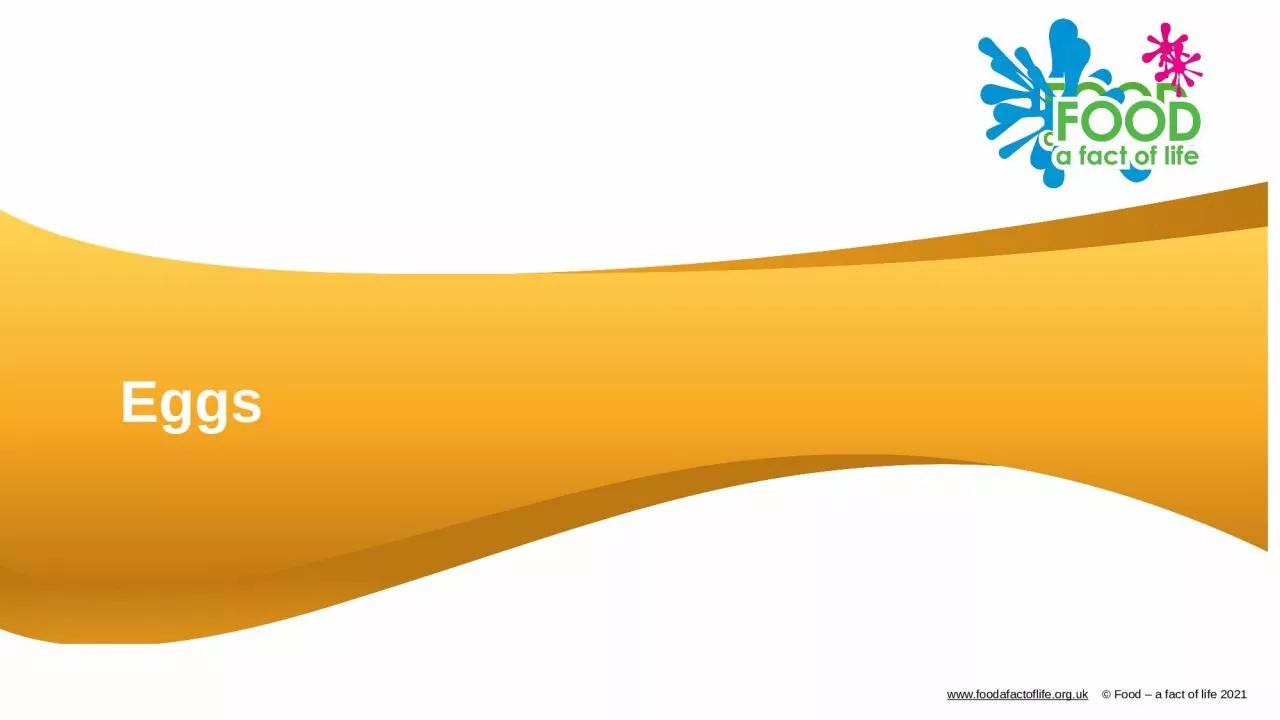

Where do eggs come from Eggs are laid by hens During 2019 in the UK 13093 million eggs were eaten 11388 million eggs were produced 1676 million eggs were imported and 271 million eggs were ID: 932353
Download Presentation The PPT/PDF document "Eggs All these dishes include egg" is the property of its rightful owner. Permission is granted to download and print the materials on this web site for personal, non-commercial use only, and to display it on your personal computer provided you do not modify the materials and that you retain all copyright notices contained in the materials. By downloading content from our website, you accept the terms of this agreement.
Slide1
Eggs
Slide2All these dishes include egg
Slide3Where do eggs come from?
Eggs
are laid by hens.
During
2019, in the UK:
13,093
million eggs
were eaten;11,388 million eggs were produced;1,676 million eggs were imported and 271 million eggs were exported.Hens are reared in three different ways to provide eggs in the UK.
Source: www.egginfo.co.uk
Slide4Enriched colony cage egg production
Between 40-80 hens share an enriched colony cage.
Bird space in enriched colony cages is
750cm² per hen.The space allows the bird to perch, lay their eggs and scratch.
Manure is removed two or three times a week from revolving belts underneath the colony.Food and water is
provided,
and the temperate and light is controlled.
Source: NFU
Slide5Barn egg production
Hens are able to move freely around the
barn.
Current legislation stipulates that there is a maximum of 9 hens per square metre of useable space.
Nest boxes are provided, one per five hens. Alternatively, communal nests are providedPerches allow for 15 centimeters of space per hen.
Food and water is
provided,
and the temperate and light is controlled.
Slide6Free range egg production
Hens have access to the outside at all times.
Legislation stipulates that, to be ‘free range’, there must be no more than 2,500 hens per hectare.
There are nest boxes and perches for the hens.Around one-third of the ground is used for scratching and dust bathing.
Many farmers plant trees to provide hens with shelter and a feeling of security outdoors.Hens are fed automatically ensuring a constant supply of fresh food. Food consists mainly of grain, such as wheat, along with soya mea, and vitamins and minerals.
www.lovefreerangeeggs.co.uk
Slide7Eggs in the UK
Over 90
% of UK eggs are stamped with the ‘lion’ mark – showing that they are safe to eat.
The Lion Code of Practice sets stringent requirements throughout the production chain to ensure quality, freshness and the highest standards of food safety.Hens are vaccinated against Salmonella Enteritidis
and Salmonella Typhimurium.Raw, partially cooked and fully cooked British Lion eggs are safe to eat by pregnant women.*
* Source:
NHS
www.egginfo.co.uk
Slide8British Lion Mark egg labelling
British Lion Mark
Method of production
0 = Organic
1 = Free Range
2 = Barn
3 = Caged
Producer identity - a unique code denoting where the egg was produced
Best before date
Slide9Eggs sizes
Eggs are now sold in four different sizes: small, medium, large and very large.
Mixed weight boxes are
also now
available which contain different sized eggs.You may come across an older recipe that asks for an egg in size 0 – 7. The chart below shows the equivalent sizes.
Weight
New size
Old size
73g and over
Very large
Size 0
Size 1
63 – 73g
Large
Size 1
Size 2
Size 3
53 – 63g
Medium
Size 3
Size 4
Size 5
53g and under
Small
Size 5
Size 6
Size 7
Slide10Parts of
an egg
Eggs have three main parts:
Shell
Yolk
White
Slide11Uses of eggs
Eggs can be boiled, poached, fried or scrambled.
Slide12Uses of eggs
The white of an egg can be whisked to make a foam.
The mechanical action of whisking incorporates air to form a foam.
The foam can be used to make meringues.
Slide13Uses of eggs
Eggs are used to make omelettes and quiche.
When egg is cooked it changes colour and becomes firmer (sets).
This is known as coagulation.
Slide14Uses of eggs
Eggs are used in cakes. They:
trap air (aerate) when
whisked into a foam;coagulate (set) on heating;emulsify holding the fat in an emulsion which keeps it stable;
add colour, flavour and nutritional value.
Slide15Uses of eggs
Eggs are used to bind ingredients together, e.g. fish cakes and croquette potatoes.
Raw egg combines the other ingredients and during cooking the protein in the egg coagulates, keeping the fishcake, or croquettes, together
.Egg also helps ‘stick’ the breadcrumbs to the outside of the fishcake or croquettes.
Slide16Uses of eggs
Eggs
can be used as a glaze, e.g. bread.
Beaten egg is brushed over the surface before cooking. The surface of the food takes on a shiny, golden-brown appearance due to coagulation of egg proteins and the Maillard browning reaction.
Slide17Eggs from other types of poultry
Eggs from other poultry can also be eaten:
duck;
emu;
goose;guinea fowl;pheasant;rhea;turkey; ostrich;
quail.
Guinea fowl
Goose
Quail
Duck
Rhea
Slide18Eggs
For further information, go to:
www.foodafactoflife.org.uk
This resource meets the
Guidelines for producers and users of school education resources about food
.